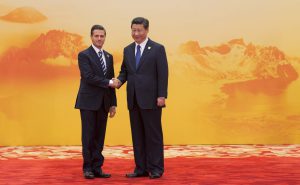Mexico will this year launch a national carbon emissions trading system, which is expected to include some 500 companies. The new scheme’s objective is to provide funding for projects to help curb the impacts of climate change, which is already affecting many areas of the Latin American country.
Around 100 Mexican companies are already participating in a physical market in California to determine how carbon market prices will be set at home, according to Rodolfo Lacy, undersecretary for planning and environmental policy at Mexico’s Ministry of Environment and Natural Resources (SEMARNAT).
“Those that exceed the 25,000 tonne carbon limit will be able to reduce it through direct mitigation measures, or they can acquire credits on reductions from other companies,” Lacy told Diálogo Chino. He added that these companies will be obliged to register their emissions and submit a reduction proposal to the federal government.
Emissions trading schemes establish a total emissions allowance among participating companies, with those emitting over a given amount able to purchase permits from those emitting less. Among the companies that are already required to comply with Mexico’s new rules are oil refineries, thermoelectric power plants, the cement and steel industries, and railway and aviation companies.
From national pilot to regional driving force
The launch of the pilot project indicates another important step forward for Mexico in the fight against climate change. Mexico was the first developing country to announce its carbon emission reduction targets to the United Nations (UNFCCC) in 2015.
Mexican companies have been able to voluntarily participate in a pilot carbon market project. In 2013 the Mexican Stock Exchange launched the Mexican Carbon Platform (known as MÉXICO2). Only in June last year, however, did congress modify the general law on climate change to make the initiative mandatory for all companies that emit more than 25,000 tonnes of carbon annually.
“We believe that there may be 500 or more participants in the carbon market in our country emitting more than 400 million tonnes, and the price is established by the balance of supply and demand,” said Lacy.
MÉXICO2 applied to the private sector to develop and determine the methods of trading credits for reductions in greenhouse gas emissions.
This platform is considered the first carbon bond market in the country and enables companies to reduce the impact of “green taxes”, in force since January 2014. The initiative will also generate resources that will finance environmental projects.
“During this pilot phase, we will conduct authentic transactions within companies and test what works and what does not,” Lacy said.
Once the national carbon market is operational, the federal government intends to link it with those of California and the Canadian province of Quebec, an existing international market, which Ontario province has already joined.
“We have talked about creating a market for North America, but for this to happen we have to consolidate our market using the same regulations. We are doing just that within the Mexican Stock Exchange as there are international standards for everything relating to trade,” Lacy said.
Mexico currently sells bonds to California at three dollars per tonne of carbon, an average price internationally, although these bonds are not part of the formal auction.
“For example, Disney is buying reductions of greenhouse gases from us in the forests of [the state of] Oaxaca. To do so, Disney asked Oaxacan community members to follow a work protocol to ensure that these reductions are achieved within a certain period of time,” said Lacy, adding that the procedure for buying and selling in a formal carbon market is more open, similar to the way stocks are purchased on the stock exchange.
Carbon markets, whose transactions worldwide amount to more than US$40 billion a year, represent an essential strategy in mitigating climate change, said Eduardo Piquero, director general of MÉXICO2.
The auctions create opportunities for investment in renewable energy projects in the poorest communities in Mexico, including installing rooftop solar panels and offering of incentives for the purchase of electric cars.
“Our role [within the Mexican Stock Exchange] is to support the development of the carbon market in the private sector. It takes a vast amount of information for companies to understand what a carbon market is, who can participate, and who cannot. Eventually, it can influence public policy so that the carbon market does not affect the competitiveness of the private sector,” Piquero said.
Piquero said the decision will be made this year as to which economic sectors and companies will participate in the carbon market.
Lacy reported that Mexico also works with several countries and local governments in the Americas to present a joint vision for regional cooperation on carbon pricing in the Americas.
At the recent “One Planet” summit in Paris, heads of state and government from Canada, Chile, Colombia, Costa Rica, and Mexico, as well as the governors of California and Washington in the US, and the prime ministers of Alberta, British Columbia, Nova Scotia, Ontario and Quebec, all in Canada, launched the cooperative framework the “Carbon Pricing in the Americas (CPA)”. In it, they pledge to work together to strengthen monitoring, reporting and verification systems for greenhouse gas emissions.
“This is an unprecedented step for Mexico and Latin America. By adopting this declaration, we recognise the enormous potential of collaboration on the continent to continue expanding, strengthening and merging our carbon markets,” said Mexican president Enrique Peña Nieto on the pilot phase of the carbon market.
Meanwhile, outgoing Chilean president, Michelle Bachelet, said that the economies of the region cannot deny the impacts of climate change. By establishing a carbon price, participating countries encourage the market to influence climate action at a lower cost.
“When economic and environmental objectives are aligned, sustainable development becomes inevitable. That is why we are happy that the price of carbon extends throughout the Americas, so that more people will benefit from climate mitigation,” she said.
The objective of the programme is to establish a common base for various carbon markets launching in the coming months.
In the future, CPA will serve as a platform for cooperation among its different jurisdictions and will aim to increasingly align carbon pricing systems and promote carbon markets. As a model, they will use successful initiatives, such as climate change mitigation platform the Partnership for Market Readiness (PMR).
PMR promotes action to strengthen the implementation of carbon prices as a central policy instrument for climate action, the Mexican government said. It also aims to facilitate the shift towards clean energy, innovation and the promotion of sustainable economic development.
“Connecting our carbon markets in the Americas will be key to reducing costs and providing flexible mechanisms to all companies in the region,” said José Oriol Bosch, president of the Mexican Stock Exchange.
A global carbon marketplace?
The governments of Mexico and Canada, as well as the United States Climate Alliance, which consists of 15 US states, last November announced they will work together on a North American climate agreement to combat global warming. A preview of the project will be presented in September 2018, at a global climate meeting in San Francisco, California.
North American governments will also seek to strengthen initiatives so that there is a greater commitment to the reduction of carbon emissions by the time the 24th United Nations Conference on Climate Change (COP24) is held in December 2018.
The United States Climate Alliance seeks to reduce greenhouse gas emissions to below 2005 levels by the year 2025. This scheme exists alongside is in addition to the European Union’s Emission Trading System (EU ETS), the pioneering carbon market inaugurated in 2005.
Days after the launch of the Mexican carbon trading system, China, the world’s largest emitter, launched a national carbon market which will initially cover the energy sector. It will then be applied in eight others. In 2015, Chinese President Xi Jinping announced plans to create a nationwide Chinese carbon market following the implementation of provincial and city-level pilot schemes.
Though it covers only the energy sector, the Chinese carbon market will be the largest in the world.







